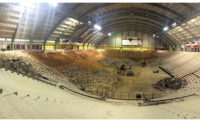Charged with developing a "living laboratory" to demonstrate energy-saving solutions in existing buildings and sustainable strategies in new facilities, the team behind the Consortium for Building Energy Innovation project at the Philadelphia Navy Yard faced a formidable challenge to bring together a wide variety of high-performance building systems.
But creating the collaborative environment to achieve the project's objectives proved to be just as challenging. With completion scheduled for late summer, the CBEI team's approach is expected to yield a project with expanded scope that also exceeds targeted energy goals and stays on budget.
The project originated in 2011, when the U.S. Dept. of Energy established the Greater Philadelphia Innovation Cluster—now called the Consortium for Building Energy Innovation. The goal: to research energy efficiency and create "pathways to 50% energy reduction in existing buildings by 2030." CBEI comprises 14 organizations, including major universities, global industrial companies and national laboratories from across the U.S. Penn State University leads the consortium. Although numerous stakeholders would need to be involved in developing the facility, the project's funding sources provided the first significant challenge. The project's $33-million budget includes $30 million from the Pennsylvania Dept. of General Services (DGS) and $3 million from the U.S. Economic Development Administration. The EDA funding came with the condition that an integrated project delivery method be used. But DGS procurement rules would not allow a contractor to be selected before design and bidding documents.
Modified Integrated Delivery
The team's solution was to create a modified integrated project delivery approach that would encourage collaboration but respect public bidding rules. KieranTimberlake, Philadelphia, was hired as lead architect. One month later, Balfour Beatty Construction, Washington, D.C., was hired as construction manager-as-agent. By retaining Balfour Beatty as an agent for the client, prime contracts were held by the owner.
"We went as far was we could with an integrated design process without the prime contractor that was doing the work," says Steve DiBartolo of Hill International, which serves as Penn State's project manager. "We engaged [mechanical and electrical] contractors to assist us during the design phase with the caveat that they would be excluded from bidding [on the construction phase work]."
To help establish guidelines for team integration, the KieranTimberlake and Balfour Beatty contracts included addendums for collaboration and building information modeling .
From the project's early days, KieranTimberlake and Balfour Beatty worked with CBEI to establish project values, rather than goals, says David Riz, KieranTimberlake principal. During pre-design workshops, the team established project values such as collaboration, learning, performance, predictability and certainty. By setting values, Riz says the team could better determine the project's most important elements, along with a wish list of additional elements.
"Often projects start with goals, but not values," he says. "Goals are what you hope to achieve as an end result, but often projects end up following the same processes over and over to achieve that .… Because we had that conversation about values, it allowed us to focus on the areas where we should spend money and where we shouldn't."
Under the team's integrated design approach, Riz says the team's meeting schedule was "three of four times that of a traditional approach." For example, the team typically met once or twice a week during schematic design to discuss building systems.






Post a comment to this article
Report Abusive Comment